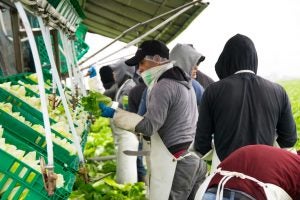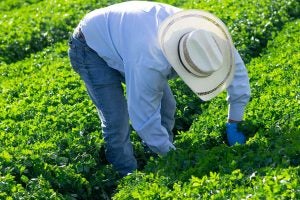Amid contentious political debate, dismal crop price forecasts, and the potential for produce to remain unpicked in the fields, American farmers argue their biggest challenge is finding enough workers. And the ongoing issue of immigration is smack dab in the middle of it all.
Given recent trends observed in the administration of President Donald Trump, immigrants with questionable, or in some cases, openly illegal status, are facing tough odds. What this means for agriculture is being hotly debated around not only the country, but the world, amid talks of trade wars with China and Mexico impacting soybeans and corn. In the meantime, farmers are stuck trying to locate workers, a task made difficult by the fact that so many agriculture-production jobs are performed by immigrants from south of the border with Mexico. Increased wages offered, and now, an increased interest in robots and automation, are all on the table.

By the Numbers
It’s difficult to overstate the impact immigrants have on the U.S. agricultural system these days, as some 70 percent of total farm labor is performed by foreign workers. According to the U.S. Bureau of Labor Statistics, average annual employment in agriculture rose 8 percent between 2005 and 2015, up to over 1.2 million, with food manufacturing and processing rising to 1.5 million. Officials estimate that at minimum, 1 million of the 11 million unauthorized foreigners presently in the U.S. are employed on U.S. farms, making up at least 50 percent of the workforce in agriculture. This means strict enforcement of immigration and deportation laws have an instant impact on farms across the country as perhaps half the workers may be here illegally. With thousands of such individuals deported annually, farmers feel the impact.
Farmers in hard-hit states like California are hiking wages by double-digit percentages, up from $11 to $16 an hour with more room to grow. USDA reports have shown, that during week of April 9 to 15 this year, farm wages were up 4 percent from last year, across the board to $13.22 an hour. Just six states account for 59% of unauthorized immigrants according to a Pew Research report: California, Texas, Florida, New York, New Jersey, and Illinois. These numbers correspond with the volume of agricultural output in the country.
Problems Noted
In all fairness, the issue of America’s immigration system, deportations, and agricultural labor shortages didn’t sprout up overnight, and the problems have been observed for some time. Given that American farmers need between 1.5 and 2 million hired workers a year, any disruption is bound to affect business. Consider:
- Labor costs account for 48 percent of the variable cost for fresh fruits and 35 percent for vegetables
- Harvesting costs account for 60 percent to 66 percent of total production for strawberries, blackberries, and cherries. These commodities are particularly time-sensitive, bruise easily, and can go to rot quickly if not picked.
- Experts attribute farm labor shortage to as much as $3.3 billion in missed GDP growth in 2012 alone, as well as $1.3 billion in farm income unrealized that year.
- It’s estimated that had U.S. farmers not faced those issues, America would have produced an additional 89,000 jobs in 2012, and the GDP would have been 12.4 billion higher, with an additional $4.9 billion more in farm revenue.

What Farmers Say
The problems aren’t likely to dissipate any time soon. Some 72 percent of growers report workers arriving 22 days after the date of need, and the nation’s H-2A Program is providing less than 4 percent of the hired workers needed in agriculture. Surveys are finding 47 percent of growers “not at all satisfied” or only “slightly satisfied” with the program, and many report having to hire an attorney to help.
In the meantime, some are predicting automation and even robots are the future of farm labor.
Even in 2017, Steve Fried, sales manager for robotic dairy systems manufacturer Lely North America, was fielding calls from frustrated producers.
“I get calls on a daily basis and it typically stars with, ‘I don’t want to deal with this labor headache any more.”
In addition to milking, start-ups around the country are advancing robotics in fields such as weeding and cultivating, where artificial intelligence and optical sensors are doing the work once reserved for human hands and eyes. Naio Technologies, a French company, uses laser and camera guidance to navigate between fruits and vegetables, with programming designed to recognize hundreds of variations of those products distinct from weeds and other undesirables. On the harvesting side, Abundant Robotics is advancing systems able to recognize and pick apples safely from trees.
Famers have long known adversity to be the mother of all inventions, and to that extent, ingenuity seems to be growing quickly. In the short-term though, the adversity is as real as unpicked vegetables in the field, and Americans simply have to watch, wait, and write their elected officials.



